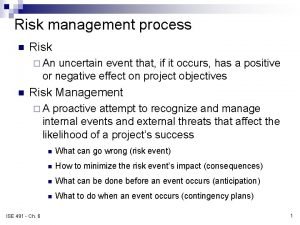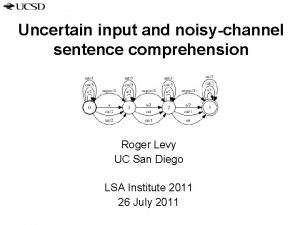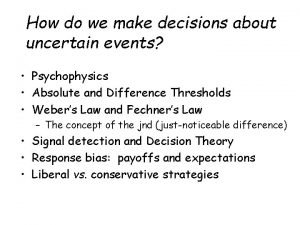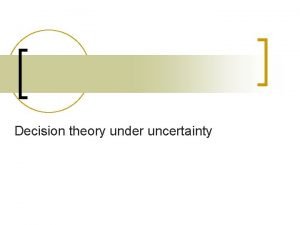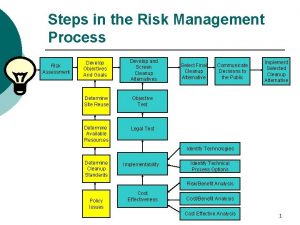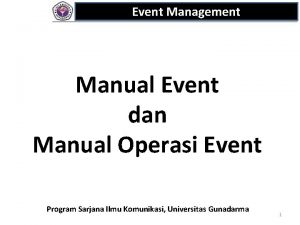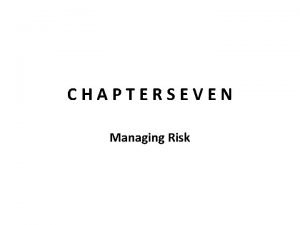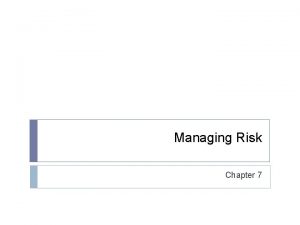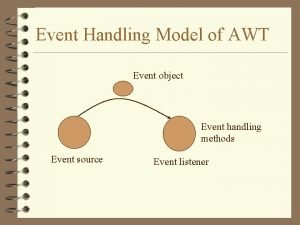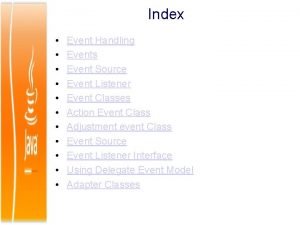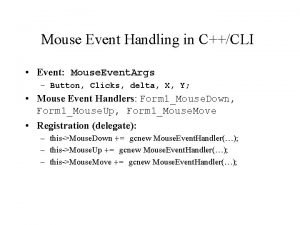Risk management process n Risk An uncertain event


















- Slides: 18

Risk management process n Risk ¨ An uncertain event that, if it occurs, has a positive or negative effect on project objectives n Risk Management ¨A proactive attempt to recognize and manage internal events and external threats that affect the likelihood of a project’s success ISE 491 - Ch. 6 n What can go wrong (risk event) n How to minimize the risk event’s impact (consequences) n What can be done before an event occurs (anticipation) n What to do when an event occurs (contingency plans) 1

The risk event graph FIGURE 7. 1 ISE 491 - Ch. 6 2

Risk Management’s Benefits n A proactive rather than reactive approach n Reduces surprises and negative consequences n Prepares the project manager to take advantage of appropriate risks n Provides better control over the future n Improves chances of reaching project performance objectives within budget and on time ISE 491 - Ch. 6 3

The Risk Management Process ISE 491 - Ch. 6 FIGURE 7. 2 4

Managing risk n Step 1: Risk identification ¨ Generate a list of possible risks through brainstorming, problem identification and risk profiling. n n Macro risks first, then specific events Step 2: Risk assessment ¨ Scenario analysis ¨ Risk assessment matrix ¨ Failure Mode and Effects Analysis (FMEA) ¨ Probability analysis n Decision trees, NPV, and PERT ¨ Semiquantitative ISE 491 - Ch. 6 scenario analysis 5

Risk breakdown structure ISE 491 - Ch. 6 FIGURE 7. 3 6

Example: Risk Profile for a product development project FIGURE 7. 4 ISE 491 - Ch. 6 7

Impact scales FIGURE 7. 5

Risk assessment form FIGURE 7. 6 ISE 491 - Ch. 6 9

Risk severity matrix 5 Red zone (major risk) User backlash Likelihood 4 Interface problems Yellow zone (moderate risk) 3 System freezing 2 Hardware malfunction 1 1 2 3 Impact ISE 491 - Ch. 6 4 Green zone (minor risk) 5 from FIGURE 7. 7 10

Managing risk (cont’d) n Step 3: risk response development ¨ Mitigating n n risk Reducing the likelihood an adverse event will occur Reducing impact of adverse event ¨ Transferring n Paying a premium to pass the risk to another party ¨ Avoiding n risk Changing the project plan to eliminate the risk or condition ¨ Sharing n risk Allocating risk to different parties ¨ Retaining n ISE 491 - Ch. 6 risk Making a conscious decision to accept the risk 11

Contingency planning n Contingency plan ¨ An alternative plan that will be used if a possible foreseen risk event actually occurs ¨A plan of actions that will reduce or mitigate the negative impact (consequences) of a risk event n Risks of not having a contingency plan ¨ Having no plan may slow managerial response ¨ Decisions made under pressure can be potentially dangerous and costly ISE 491 - Ch. 6 12

Risk response matrix FIGURE 7. 8 ISE 491 - Ch. 6 13

Risk and contingency planning n Technical risks ¨ Backup strategies if chosen technology fails ¨ Assessing whether technical uncertainties can be resolved n Schedule risks ¨ Use of slack increases the risk of a late project finish ¨ Imposed duration dates (absolute project finish date) ¨ Compression of project schedules due to a shortened project duration date ISE 491 - Ch. 6 14

Risk and contingency planning (cont’d) n Costs risks ¨ Time/cost dependency links: costs increase when problems take longer to solve than expected. ¨ Deciding to use the schedule to solve cash flow problems should be avoided. ¨ Price protection risks (a rise in input costs) increase if the duration of a project is increased. n Funding risks ¨ Changes in the supply of funds for the project can dramatically affect the likelihood of implementation or successful completion of a project. ISE 491 - Ch. 6 15

Contingency funding and time buffers n Contingency funds ¨ Funds n to cover project risks—identified and unknown Size of funds reflects overall risk of a project ¨ Budget n reserves Are linked to the identified risks of specific work packages ¨ Management n n reserves Are large funds to be used to cover major unforeseen risks (e. g. , change in project scope) of the total project Time buffers ¨ Amounts of time used to compensate for unplanned delays in the project schedule ISE 491 - Ch. 6 16

Contingency fund estimate (000 s) TABLE 7. 1 ISE 491 - Ch. 6 17

Managing risk (cont’d) n Step 4: risk response control ¨ Risk control n Execution of the risk response strategy n Monitoring of triggering events n Initiating contingency plans n Watching for new risks ¨ Establishing a change management system n Monitoring, tracking, and reporting risk n Fostering an open organization environment n Repeating risk identification/assessment exercises n Assigning and documenting responsibility for managing risk ISE 491 - Ch. 6 18
 Risk response matrix
Risk response matrix Agreement the meaning of which is uncertain
Agreement the meaning of which is uncertain Credit risk market risk operational risk
Credit risk market risk operational risk Is a near miss a sentinel event
Is a near miss a sentinel event Worksheet 12-8 compound probability
Worksheet 12-8 compound probability Independent event vs dependent event
Independent event vs dependent event Independent event vs dependent event
Independent event vs dependent event 5 ws of event management
5 ws of event management Newsworthy event background event source
Newsworthy event background event source Newsworthy event (s) background event (s) sources
Newsworthy event (s) background event (s) sources Key risk indicators for vendor management
Key risk indicators for vendor management Risk map
Risk map Certain and uncertain digits
Certain and uncertain digits Levy in a sentence
Levy in a sentence Kode icd 10 oat
Kode icd 10 oat Representing knowledge in an uncertain domain
Representing knowledge in an uncertain domain Uncertain events
Uncertain events Uncertain examples
Uncertain examples Steps in risk management process
Steps in risk management process
